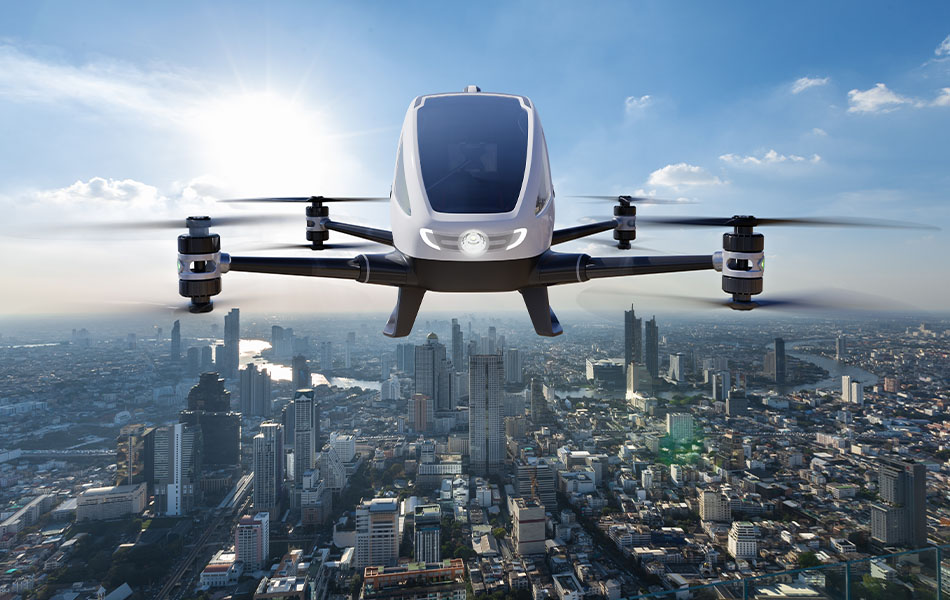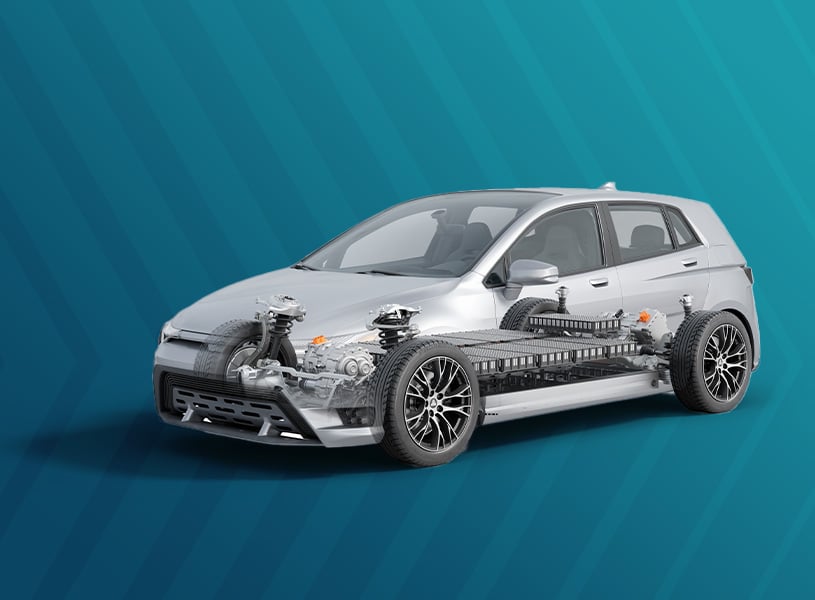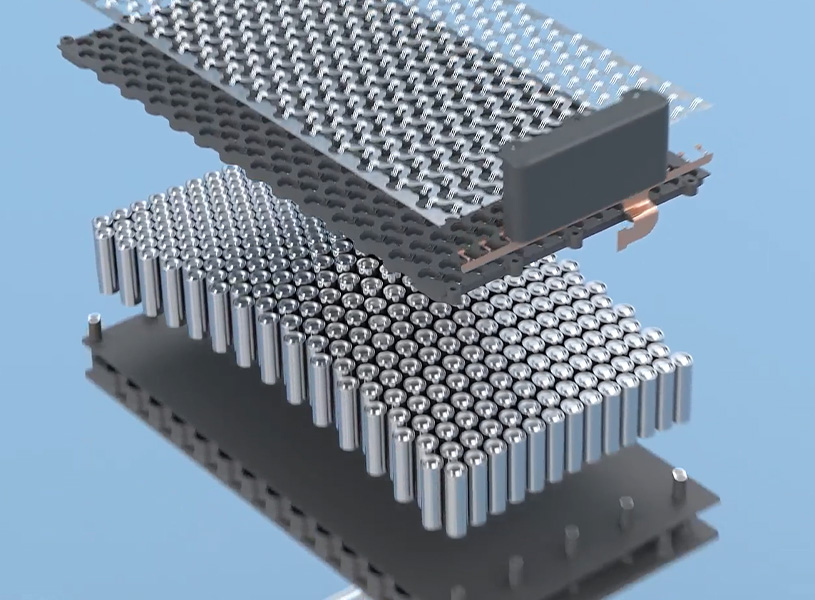
Battery Design and Simulation Software
Safe, affordable, and efficient high-capacity batteries are vital for electric vehicles (EVs) and renewable energy adoption in transportation and heavy equipment systems. Altair's vehicle safety and battery research synergizes simulation expertise with artificial intelligence (AI) technology to accelerate the development of next-gen battery-powered e-mobility systems.
From battery manufacturing to multiphysics system optimization, Altair’s battery design and simulation software provides a holistic approach to battery-powered mobility. Connected multidisciplinary workflows enable product developers to balance
competing technical requirements with performance, safety, and sustainability demands. These workflows also leverage digital twin capabilities that can monitor system health and reveal actionable insights at any lifecycle stage. No other offerings
come close to Altair’s cohesive AI-powered battery modeling and simulation solutions that are driving the future of e-mobility.No other offerings come close to Altair’s cohesive AI-powered engineering battery modeling and simulation solutions that are driving the future of e-mobility.

Thermal Management
Ensuring Battery Reliability and Battery Safety
Operating conditions like driving profiles, high and low atmospheric temperatures, and charging rates all directly impact battery cell temperatures. Accounting for the interplay between all contributing conditions requires sound and efficient thermal management solutions.
Battery Design for Normal Operating Conditions
Battery architecture that includes optimal cooling with the structural specifications early in the design cycle significantly reduces downstream problems, which ensures faster, more reliable product releases. Tackling thermal issues under normal operating conditions with Altair® SimLab®’s CFD analysis and electrothermal analysis improves reliability and battery life. Additionally, topology optimization for battery pack busbars reduces generated heat, improves thermal dissipation, and ensures the electrical load is equally distributed across all cells within the battery pack.
Preventing Thermal Runaway
Achieving the optimal balance between energy density and safety is essential. Multiphysics simulation with SimLab ensures that high-density battery packs are both efficient and resistant to thermal runaway. Specifically, companies can perform combined thermal analysis and strength simulations at the system level to account for battery weight and structural integrity, which are crucial to protecting vehicle occupants and the battery in the event of a crash.

Battery Range
Striking the Optimum Balance between EV Range, Weight, and Cost
The key to improving battery range and battery life are lightweight systems with high-capacity battery packs that maintain long-lasting performance. Altair’s multiphysics solutions optimize competing parameters within a holistic battery design simulation environment that captures the interplay of electrical, thermal, structural, and control systems to extend battery pack life.
Battery Structural Integration
The relationship between the battery, its tray, and the vehicle's structural design plays a crucial role in determining EVs’ weight and structural integrity. Altair's automated lightweighting and optimization processes give design teams the freedom and efficiency to experiment with different battery packaging, manufacturing, and structural strategies at the concept design stage and throughout the product development cycle. Data- and physics-informed AI design solutions in Altair® HyperMesh® workflows enable organizations to perform rapid design explorations and gain insights that other simulation processes simply can’t deliver.
Optimized Charging for Maximum Battery Range
Companies need to meet design requirements for charging batteries in a heterogeneous infrastructure. Power electronics solutions like Altair® PSIM™ can address the many challenges such as AC-DC and DC-DC power conversion technology requirements for efficient charging; energy feedback into smart grids; and fast charging that can be deployed for private EVs and commercial EV fleets.
Battery Management System Software
E-Drive Integration and Controls
Meeting battery management system (BMS) requirements for e-transportation is no small feat. Solutions like Altair® Twin Activate™ and Altair Embed® provide you with powerful battery and e-powertrain system simulation capabilities that can address voltage, current, and temperature as well as efficiency, safety, range, and dependability.
Digital Twin for Optimal EV Battery Management
Phenomena such as battery aging are difficult to study with traditional simulation methods. With trusted digital twins deployed with data- and physics-informed capabilities like Altair® romAI™, engineers can address aging and other critical electrification challenges, including battery design and performance optimization for thermal management, multiphysics verification, and systems integration. For all stages – from concept design to end-of-life planning – organizations gain a competitive advantage by leveraging Altair digital twin solutions throughout the battery lifecycle.
Discover how Danecca is disrupting the battery development process with an intelligent digital twin.
Rapid Battery Concept Design
Delivering best-in-class battery designs requires engineers to rapidly create, test, and compare different battery cell, module, and pack configurations. To streamline this process, Twin Activate’s Energy Storage Library offers predefined battery cell and pack 1D models and equivalent circuit models (ECMs) that simplify complex battery development.

Battery Life Prediction with Frictionless AI
Accelerating Innovation with Data and AI
Accurate battery cycle-life and calendar-life prediction is essential for developing safe, reliable energy storage systems. Altair® RapidMiner® data analytics solutions help product development teams make these predictions by turning their measurement data, test data, field data, and synthetic data from simulations into decision information. With Altair RapidMiner’s AI-powered and data-driven modeling, teams can leverage key performance indicators such as range, remaining useful life (RUL), efficiency, and energy density to determine battery performance in the field and predict battery lifetime. Additionally, they can determine effective temperature and load management that impacts battery life, performance, and recycling frameworks.
Discover how Altair's battery design solutions can help your product development.
Contact Us
Battery Modeling for Impact and Crash Safety
Meeting today’s battery safety requirements demands comprehensive simulation solutions like HyperMesh, Altair OptiStruct®, and Altair® Radioss®. Through a connected software development environment, engineering teams can study complex and interconnected battery behaviors across normal and extreme duty cycles; model and predict mechanical damage and thermal runaway from crash and impact scenarios; and optimize designs for safety and performance.
Additionally, teams can leverage integrated AI-powered workflows that deliver fast physics predictions from any historical data. With these predictions, engineers can explore more design possibilities than ever before and accelerate superior e-mobility innovation.
Discover how Altair multiphysics solutions predict and prevent EV battery fire.
Revolutionary new vehicle concepts are inspiring designers to rethink ways of minimizing weight and manufacturing costs while meeting performance and safety targets. Technologies that can handle critical components like mega- and giga-castings are required. Designers are finding their complete solution with Altair’s bespoke workflows that blend industry expertise with breakthrough artificial intelligence (AI), generative design, and advanced computer aided engineering (CAE) for multidisciplinary design exploration and optimized manufacturability.
Battery Cell Design, Manufacturing, and Recycling
Developing Efficient Battery Cells
Rapid and effective battery cell development requires tools that can simulate battery components at the particle scale to predict and optimize the electrode microstructure. With the groundbreaking discrete element methodology in Altair® EDEM™, engineers can virtually test, predict, and optimize electrode microstructures and gain in-depth insight into the effects of material properties and manufacturing process conditions on battery behavior and performance.
Innovating Battery Manufacturing Processes
Next-generation battery production requires solutions that can simulate the key stages of active material and electrode manufacturing processes: mixing, coating, drying, and calendering. EDEM simulates these stages to uncover the critical relationship between process parameters and key performance indicators so organizations can rapidly optimize their processes to ensure efficient, reliable battery manufacturing operations.
Battery Recycling and Sustainability
Efficient, safe, and cost-effective end-of-life management is essential for sustainable battery production. With EDEM’s raw-material handling simulation solution, engineering teams can optimize critical battery recycling processes like shredding, drying, sieving, and separation to meet all manufacturing challenges and foster a safe, sustainable battery-driven future.

Altair One®
Access collaborative simulation and data analytics technology plus scalable HPC and cloud resources through Altair One®, our cloud innovation gateway. Altair One lets you provision scalable resources in the cloud or on-premises through a single pane of glass; run cloud versions of your favorite software; and run simulation jobs in the cloud.
With Altair One, you can solve any battery challenge in one place:
- Battery Architecture
- Battery Cells
- Battery Modules
- Battery Packs
- Battery Systems
- Battery Charging
- Battery Safety
- Battery Integration
- Battery Cooling System
- EV Battery Management
- Automotive BMS
- Battery Range
- Battery Life
- Battery Recycling
Featured Resources

Digital Transformation Series: Design and Integration of Battery Packs
This webinar introduces a robust simulation-driven battery design and validation solution that incorporates the interaction with the battery management system.
Altair’s unique FE-based approach to battery thermal management lets you simulate a 900-sec drive cycle in 8 hours for a complete pack. Our solver technology enables the assetization of model descriptions and enables you to handle all relevant applications with the same baseline model.
Using the native optimization capabilities across the Altair technology stack, Multiphysics optimization and design exploration can be executed efficiently and quickly.

Creating an Intelligent Digital Twin to Optimize Battery Performance
This presentation and live demonstration from Altair and battery specialist Danecca showcases a Digital Twin which presents a virtual representation of a physical battery pack subject to a transient duty cycle. The Digital Twin mimics the embedded control logic of the hardware to manage system heating and cooling during the event. Capturing the complex physics and system response with the Digital Twin in timescales commensurate with the physical hardware enhances the role of simulation within the UK battery development community. The battery Digital Twin presents new opportunities for rapid, holistic, design exploration and innovation.
This presentation was part of the 2nd Altair Northern UK Seminar and was filmed live in Newcastle, UK in December 2022.
Speakers: David White, Battery Systems Engineer, Danecca and Dr. Royston Jones, CTO, Altair
Duration: 18 minutes

From Micro to Macro: Optimizing Battery Design and Manufacturing
Battery cell manufacturing is critical to the advancement of clean energy technologies, particularly in electric vehicles (EVs), renewable energy storage, and portable electronics. Altair offers a comprehensive suite of solutions to support the development of efficient and sustainable battery cells, from the microstructure of the raw electrode material to the battery cell life cycle.

Advanced Simulation for Electric Vehicles: Lightweight Solutions and Thermal Management
There is a global need for reduced energy consumption, and along with the mass electrification of the automotive sector, this necessitates a continual quest for the optimal balance between vehicle mass and performance.
BeonD is a pioneer in this challenge, engaging in the multidisciplinary development of components and solutions with the ultimate goal of maximizing performance. Specifically, BeonD analyzes the methodology for developing composite components, starting from material characterization through final component validation, all while utilizing Altair Radioss.
In this presentation, BeonD will showcase a case study involving correlation and sensitivity in relation to thermal management of the battery pack. This study commences with an experimental analysis of a single cell and progresses to the identification and analysis of cooling strategies; which were conducted using Altair OptiStruct.
Davide Berti Polato, CAE, CFD, & NVH Manager | BEOND s.r.l
Andrea Carcone, CAE & Performance Engineering Manager | BEOND s.r.l.
Presented at the ATCx Electrification for Engineers in September 2023, 28 mins
The presentation is in English by default. The following languages are available by clicking on Audio Description ('AD') on the video screen: , KR, JP, DE, FR, IT, and PT.





